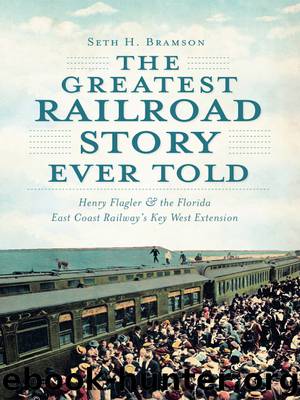The Greatest Railroad Story Ever Told by Seth H. Bramson

Author:Seth H. Bramson
Language: eng
Format: epub
Publisher: Arcadia Publishing Inc.
Published: 2013-04-07T04:00:00+00:00
Islamorada Depot was as substantial as those on the mainland. While the group in the photo is not identified, it is clear that, with restrooms reading “White” and “Colored” behind the men, segregation was in full force in the Keys at that time. Courtesy Barbara Edgar and the Eyster family.
The reader should now be made aware that there is a distinct difference, in railroad parlance, between a station and a depot. The former is any named location at which a train may stop, but that station may not necessarily be the site of a building or any actual physical facilities for passengers to use while they are waiting for their trains or after detraining. In fact, south of Florida City and north of Key Largo, there were two stations that were no more than lightly surfaced gravel areas without even the amenity of a wooden platform to be used as a waiting area. Those two stations (not depots) were Wooddall and Everglades (later known as “Glades”), and they are shown in the FEC timetables as “flag” stops, which meant, of course, that if the passenger wanted the train to stop, he had to wave a handkerchief (or his arm) in the daytime, or a bright light at night, to indicate to the engineer that he was waiting for that particular train.
Those two stations, incidentally, as well as the station called Jewfish at MP 415, were used almost exclusively by hunters and fishermen and, interestingly enough, saw a surprisingly regular stream of passengers boarding and detraining with fishing or hunting gear and a good bit of camping accessories rather than the regular luggage carried by most passengers.
The other type of station is a depot, and these are stations at which there is some form of physical accommodation for passengers, in some cases as minimal as a shed to protect them from rain, but in most instances with at least a sheltered waiting room.
Most of the FEC depots on the extension operated without an agent but did have shelter for passengers, and many may have had restrooms, which in the days of segregation would have been separated by race. All of the stations are shown in the image of the FEC’s timetable. In that timetable, an “f” indicates a flag stop, as discussed above.
Download
This site does not store any files on its server. We only index and link to content provided by other sites. Please contact the content providers to delete copyright contents if any and email us, we'll remove relevant links or contents immediately.
| Africa | Americas |
| Arctic & Antarctica | Asia |
| Australia & Oceania | Europe |
| Middle East | Russia |
| United States | World |
| Ancient Civilizations | Military |
| Historical Study & Educational Resources |
Cat's cradle by Kurt Vonnegut(14760)
Pimp by Iceberg Slim(13779)
Underground: A Human History of the Worlds Beneath Our Feet by Will Hunt(11839)
4 3 2 1: A Novel by Paul Auster(11792)
The Radium Girls by Kate Moore(11621)
Wiseguy by Nicholas Pileggi(5319)
American History Stories, Volume III (Yesterday's Classics) by Pratt Mara L(5136)
Perfect Rhythm by Jae(5072)
The Fire Next Time by James Baldwin(5017)
Paper Towns by Green John(4800)
Pale Blue Dot by Carl Sagan(4618)
A Higher Loyalty: Truth, Lies, and Leadership by James Comey(4552)
The Mayflower and the Pilgrims' New World by Nathaniel Philbrick(4281)
The Doomsday Machine by Daniel Ellsberg(4246)
Killers of the Flower Moon: The Osage Murders and the Birth of the FBI by David Grann(4189)
Too Much and Not the Mood by Durga Chew-Bose(4095)
The Sympathizer by Viet Thanh Nguyen(4095)
The Borden Murders by Sarah Miller(4019)
Sticky Fingers by Joe Hagan(3912)
